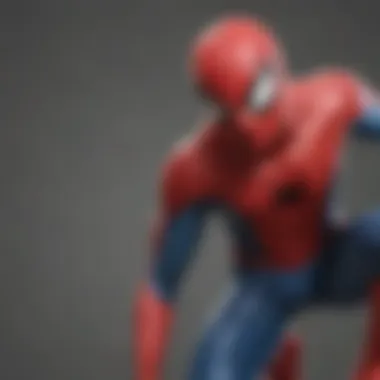The Impact of Spider-Man Cartoon DVDs on Pop Culture


Intro
The realm of Spider-Man has consistently captivated audiences through various media, notably in animated form. From the earliest television specials to the numerous DVDs that now catalog these beloved cartoon adaptations, the journey of Spider-Man's animation evolution is rich and multifaceted. This exploration not only chronicles the production and adaptations over time but also highlights the impact these cartoons have had on fans and the overall franchise.
Spider-Man's presence in animation has redefined storytelling within the superhero genre. Each adjustment and stylistic choice made by the creators has contributed to the character's identity and cultural resonance. Alongside this journey, we witness the transition from physical DVD collections to digital formats, marking a significant chapter in how audiences interact with these iconic tales.
Given the nuances behind this evolution, we will delve into various dimensions, including character analyses, adaptations, and an overview of the ongoing developments in the Spider-Man franchise. Readers will be invited to explore the intricate relationship between Spider-Man's cartoons, their adaptation over time, and the immense fandom they have nurtured.
Spider-Man Character Analysis
Background
Spider-Man first appeared in Amazing Fantasy #15 in 1962, created by Stan Lee and Steve Ditko. This origin story introduces us to Peter Parker, a teenager who gains extraordinary abilities after being bitten by a radioactive spider. Over the years, Spider-Man has become a profound symbol of resilience, grappling with the complexities of adolescence alongside his responsibilities as a superhero. The character’s evolution is marked by significant milestones, such as the transition from the classic animated series in the 1960s to the more modern adaptations seen on television and DVD.
Powers and Abilities
Spider-Man possesses an array of unique powers, which play a central role in both his character and the narratives that surround him. Key abilities include:
- Wall-Crawling: The ability to cling to surfaces allows Spider-Man to navigate complex urban landscapes effortlessly.
- Superhuman Strength: His enhanced physical capabilities enable him to perform incredible feats of strength.
- Spider-Sense: A precognitive ability that alerts him to danger, enhancing his reflexes in combat.
- Web-Slinging: Using web-shooters, Spider-Man can create webbing to swing through the city and capture foes.
These powers contribute to his dual identity, reflecting his struggles as both Peter Parker and Spider-Man.
Character Development
Spider-Man's character growth is significant, shaped by pivotal moments throughout his story:
- The loss of Uncle Ben instills in him the mantra, "With great power comes great responsibility."
- Relationships with allies like Mary Jane Watson and Gwen Stacy are crucial, providing depth and emotional weight.
- Encounters with formidable foes lead to self-realization and sharpen his resolve.
Through various adaptations, including the popular cartoons on DVD, these character developments resonate, making Spider-Man relatable and enduring.
Latest Spider-Man News Update
Comic Books
Recent releases in the Spider-Man comic book series have showcased new story arcs and character developments, exciting long-time readers and drawing in new fans. The storyline often reflects contemporary issues while retaining the core essence of the character.
Movies
In cinema, the buzz around upcoming Spider-Man films remains vibrant. Fans are eagerly anticipating news on casting and trailers that promise rich storytelling and thrilling action. The cinematic adaptations of Spider-Man continue to explore his character in innovative ways, connecting with diverse audiences.
Video Games
The video game sector also recently released new titles featuring Spider-Man, including Marvel's Spider-Man: Miles Morales. Gameplay enhancements and additional downloadable content (DLC) focus on further immersive experiences, giving fans new narratives to explore.
Top Villains in Spider-Man Universe
Main Antagonists
Spider-Man's rogues’ gallery is iconic, featuring villains such as:
- Green Goblin: A central figure in Spider-Man’s lore, often embodying the chaos of his dual life.
- Doctor Octopus: A brilliant scientist turned villain, known for his mechanical tentacles and strategic mind.
- Venom: A complex character born from an alien symbiote that presents a menacing challenge for Spider-Man.
Origins and Motivations
Understanding these villains often involves delving into their backstories:
- Green Goblin (Norman Osborn): His descent into madness is rooted in personal loss and rivalry with Spider-Man.
- Doctor Octopus (Otto Octavius): A tragic figure whose ambition leads him to villainy, often representing the darker side of scientific pursuit.
- Venom (Eddie Brock): His antipathy towards Spider-Man stems from a mix of personal vendetta and the alien symbiote's influence.


Memorable Battles
Historic confrontations between Spider-Man and his adversaries have defined the narrative landscape, showcasing both physical combat and ideological clashes. Notable battles often emerge in animated adaptations, emphasizing the thematic weight of these conflicts.
Spider-Man Movie Reviews
Plot Summary
Recent Spider-Man movies have captivated audiences with adventurous plots that reflect both personal struggle and heroism. They tackle themes central to Spider-Man's character, providing depth and engagement.
Character Portrayals
The performances of various actors portraying Spider-Man are critical in shaping public perception. Each actor brings a unique interpretation, influencing character dynamics and storytelling.
Visual Effects
Visual effects play a major role in crafting the excitement of Spider-Man's world. The CGI sequences enhance action scenes, demonstrating the creative advancement of technology in animated formats.
"The evolution of Spider-Man cartoons into DVDs reflects a broader shift in how audiences consume media, preserving the essence of storytelling while enhancing accessibility."
Foreword to Spider-Man Cartoons
The introduction of Spider-Man cartoons to the world gave rise to an evolving medium that shaped perceptions and storytelling in animation. From adpating comic book lore to newer formats like DVDs, Spider-Man's animated portrayals showcase not just a character, but a cultural phenomenon. This section illuminates why Spider-Man cartoons matter, emphasizing their role in influencing both audiences and the wider animation landscape.
Historical Context
The history of Spider-Man cartoons begins in the 1960s, when the first animated series premiered. This initial effort reflected the aesthetics and storytelling styles of its time, introducing viewers to a vibrant, albeit simplistic, portrayal of the famed superhero. The series emphasized moral lessons and often concluded with a message. Over the decades, as comic book narratives grew complex, the animations pursued greater depth.
The transition from a single series to multiple adaptations shows how the character resonated with diverse audiences. Each edition not only retained core themes but also integrated contemporary issues, making the content more relatable to the viewing demographic.
As audience expectations evolved, animators began to embrace technological advancements. The 1990s brought higher production values, with detailed character designs and intricate storylines. These adaptations often sought to capture the essence of comic books accurately while catering to both children and older fans.
Significance of Animation in Storytelling
Animation provides a unique platform for storytelling, allowing for visually engaging narratives that can otherwise be constrained by live action. Through animation, Spider-Man's world expanded beyond the limitations of physical settings.
In animated form, the vibrant colors and exaggerated movements express emotions and actions in ways that resonate strongly with an audience. This form is particularly effective in portraying Spider-Man’s agility and web-slinging abilities, making thrilling moments more impactful.
Notable elements that enhance storytelling in Spider-Man animations include:
- Character Development: They often show evolution of Spider-Man's persona, exploring his struggles and triumphs.
- Social Commentary: Episodes frequently address themes like responsibility, friendship, and sacrifice, which connect with viewers.
- Visual Style: Each adaptation utilizes varying art styles to reflect its narrative tone, drawing viewers further into the story.
From the early simplistic animations to modern interpretations, the fundamental aim remains consistent: to capture the spirit of Spider-Man and his journey in ways that engage the audience meaningfully.
Development of Spider-Man Cartoons
The development of Spider-Man cartoons is an essential facet of understanding the broader narrative of this iconic superhero's legacy. Spider-Man, created by Stan Lee and Steve Ditko in 1962, not only made an impact in comic books but also laid the groundwork for various television adaptations. Each iteration reflects evolving cultural contexts and audience expectations. The journey from early adaptations to contemporary reboots reveals much about animation's role in storytelling and character evolution.
Early Adaptations
In the late 1960s, the first animated Spider-Man series premiered, featuring a unique art style and storytelling approach that captured the essence of the comic book character. This adaptation paved the way for more animated shows, which tried to replicate the dynamic nature of Spider-Man's adventures. While these early versions often faced budget constraints and limited animation techniques, they successfully introduced the character to a broader audience. As a result, these adaptations sparked interest in Spider-Man merchandise and comics, solidifying his status in popular culture.
The Classic 1990s Series
The 1990s saw a resurgence of superhero cartoons, culminating in the release of the acclaimed "Spider-Man: The Animated Series." This series set new standards for storytelling in animated action series. It featured complex narratives, character development, and a format that respected its source material. Its impact was profound, as it introduced many viewers to key characters and story arcs from the comics. With a successful run, the show laid the groundwork for subsequent adaptations and revived interest in Spider-Man within diverse fan circles.
Modern Reboots and Variations


In recent years, the landscape of Spider-Man cartoons has transformed again. Newer adaptations like "Ultimate Spider-Man" and "Spider-Man: Into the Spider-Verse" explore various interpretations of the character. These series take advantage of modern animation techniques and storytelling capabilities. They often appeal to younger audiences while maintaining relevance among established fans. Moreover, they contribute to the broader Spider-Man narrative by introducing alternative versions of the character, rich storytelling, and innovative animation styles.
The evolution of Spider-Man cartoons mirrors the character's growth, adapting to fit cultural changes and audience diversity.
Throughout these phases, each development has added layers to Spider-Man’s rich history, emphasizing the adaptability and timelessness of the character. This evolution continues to influence not just Spider-Man’s legacy but also the broader world of animated storytelling.
From Television to
The transition of Spider-Man cartoons from traditional television broadcasts to DVD collections marks a significant milestone in the representation of the franchise. This evolution reflects not only shifts in media consumption but also in how stories are marketed and viewed by audiences. DVD releases have provided fans a tangible way to own their favorite cartoons, often enhancing the experience with additional content not available during initial broadcasts.
Impact of Digital Formats
The shift to digital formats has transformed how viewers access and engage with Spider-Man cartoons. Digital formats allow for higher quality video and sound, presenting the animation as it was meant to be seen. Fans can now enjoy clean, crisp visuals without the distortions common with older television sets. Moreover, the availability of DVD collections means that entire series can be consumed at one's own pace, significantly enhancing viewer engagement.
Additionally, digital formats facilitate easy storage and organization of collections. DVDs take less physical space than tapes or other older formats, making it simple for fans to curate their own Spider-Man library. This convenience aligns with modern consumption habits that favor on-demand access over scheduled programming.
Packaging and Presentation
The aesthetics of DVD packaging play a crucial role in attracting collectors. Well-designed artwork can evoke nostalgia and excitement. For instance, the DVD cover of the classic 1990s series is often adorned with dynamic illustrations featuring Spider-Man in action. These visuals serve not just as a means to appeal to fans but as a way to summarize the essence of the content within.
Most DVD collections also include case inserts, which may feature additional background information, artwork, and even episode guides. Such packaging elevates a simple media product into a collectible item. The careful curation of box art and inserts allows fans to connect with the franchise at a deeper level, making them feel a part of the Spider-Man community.
Bonus Features and Fan Services
One of the most compelling aspects of Spider-Man DVDs is the inclusion of bonus features. These extras can range from behind-the-scenes documentaries to commentaries that provide insights from creators and voice actors. Such features enrich the viewing experience and offer fans a chance to gain a deeper understanding of the series’ development.
Moreover, fan services have also become a staple in modern DVD releases. Some DVDs feature fan art, interviews with fans, or even community-driven sections that highlight the passion of the Spider-Man comic and animation circles. This connection creates a bond between the franchise and its audience, recognizing and validating the contributions of fans.
As a result, the transition from television to DVD has enabled Spider-Man to cultivate a dedicated fanbase that appreciates not only the stories but also the means of consuming and preserving them.
Audience Reception
Audience reception serves a crucial role in understanding the impact and evolution of Spider-Man cartoon DVDs. Evaluating how different demographics engage with these DVDs provides insight into their cultural significance. This section discusses how these products resonate with fans, the elements that contribute to their popularity, and the feedback they elicit from critics and viewers alike. It highlights the connection between source material, adaptation, and audience perception, illustrating how these interactions shape the overall success of the Spider-Man franchise.
Metrics of Popularity
Popularity metrics of Spider-Man DVDs are a valuable indicator of their success. Sales figures over the years show how well these items have fared in the market. Notably, the release of the Spider-Man: The Animated Series and the Spider-Man: The New Animated Series on DVD received significant attention. The number of units sold reflects the series' appeal across various age groups.
More than sales, streaming numbers on various platforms also shed light on how audiences consume these animations today. Streaming services like Netflix and Disney+ track viewers’ habits, forming a comprehensive picture of the Spider-Man fandom over time.
Social media presence is another dimension. Platforms like Reddit and Facebook serve as gauges for audience engagement. Fans often share their favorite moments and discuss the narrative arcs. These conversations help drive interest in DVDs, particularly for new and re-released content.
Overall, popularity can be assessed through a combination of traditional sales data, streaming analytics, and social media activity. This multifaceted approach ensures a broader understanding of audience reception.
Critics’ Reviews and Fan Feedback
Critics' reviews and fan feedback hold significant weight in shaping the perception of Spider-Man DVDs. Reviews from well-established platforms, such as Rotten Tomatoes and IMDb, offer insights into the quality of storytelling and animation in each series. Positive reviews often trigger a surge in sales and general awareness, while negative critiques can dampen enthusiasm.
On the flip side, fan feedback through online forums and social media channels brings a grassroots element to the discussion. Fans articulate what resonates with them, from character development to fidelity to the original comic books. This type of qualitative data often proves invaluable, as it reflects the sentiments of core supporters of the franchise.
"The DVD collection of classic Spider-Man episodes revives not just memories but a sense of community among fans. These stories are timeless."
In essence, both critics' reviews and fan feedback serve as a necessary feedback loop. They influence the creation of future content and provide guidance to producers on audience preferences. The Spider-Man brand thrives on this interaction, ultimately enhancing its cultural legacy.
Cultural Impact of Spider-Man DVDs
The release of Spider-Man cartoons on DVD has played a significant role in shaping the cultural landscape surrounding this iconic character. As DVDs became a popular medium for home entertainment, they allowed fans to access their favorite episodes and movies more easily. This accessibility provided an opportunity to revisit and discuss the various incarnations of Spider-Man. Importantly, the DVDs captured the evolution of the storytelling and animation techniques used in the series, making it a vital resource for understanding Spider-Man's enduring popularity.


Influence on Pop Culture
The influence of Spider-Man DVDs extends far beyond their mere entertainment value. They contribute to the broader tapestry of pop culture in several important ways. First, these DVDs serve as a nostalgic artifact for generations who grew up watching the animated series. By allowing fans to relive their childhood experiences, they foster a sense of community among viewers. This nostalgia is further amplified through forums and online communities such as Reddit, where fans share stories and discuss their favorite episodes.
Moreover, the DVDs help maintain the relevance of Spider-Man in contemporary culture. As new adaptations and films are released, the original cartoons create a foundation upon which new stories can build. This continuity reinforces Spider-Man's position as a cultural figure. For instance, elements from earlier animtions have been referenced in later films, thus enriching the narrative universe.
"Spider-Man has always been more than just a comic book character; he's a reflection of societal values and changes across decades.”
Additionally, merchandise inspired by the DVDs often finds its way onto store shelves. Toys, clothing, and collectibles feature designs and imagery from the animated series, keeping Spider-Man in the consumer’s mindset. This interplay between DVDs and merchandise helps perpetuate the character's presence in everyday life.
Role in Expanding the Spider-Man Universe
Spider-Man DVDs also play a crucial role in expanding the overall Spider-Man universe. They offer fans insights into the various adaptations and spin-off series that may not receive the same level of attention as the mainline productions. Series such as "Spider-Man: The Animated Series," and "The Spectacular Spider-Man" have gained traction. Their presence on DVD allows for easy viewing, promoting in-depth analysis and appreciation among fans.
Moreover, extras included in many DVDs, such as commentaries and behind-the-scenes features, enhance understanding of the story and character development. These insights enable fans to engage with the material on a deeper level, prompting discussions about character arcs and thematic elements that resonate beyond entertainment.
The exploration of Spider-Man's various challenges and triumphs throughout these DVDs enriches the narrative and creates a multi-dimensional character. This contributes to the ongoing evolution of Spider-Man's story, reflecting contemporary issues and values that resonate with audiences today.
Furthermore, the availability of different adaptations highlights the diversity of storytelling in animation. The various styles and approaches reflect different cultural influences, making Spider-Man a character that can appeal to a wide audience across demographics. This expanded universe ensures that Spider-Man remains relevant and relatable, ensuring his legacy continues in new and unexpected ways.
Looking Ahead
Looking ahead in the realm of Spider-Man cartoons and their DVD releases, several compelling themes arise. This section dives into the future prospects for Spider-Man in animation and the potential technological advancements in DVD formats. Understanding these elements can help fans, creators, and industry insiders anticipate how this beloved character may evolve in the years to come.
Future of Spider-Man in Animation
The future of Spider-Man in animation appears promising, shaped by ongoing trends in media consumption and storytelling techniques. Recent developments suggest a growing demand for diverse narratives that appeal to a broader audience. Animated series, such as "Spider-Man: Into the Spider-Verse," have successfully introduced new ideas and characters, demonstrating the franchise's capacity to innovate.
Factors influencing the future of Spider-Man animation include:
- Technological advancements: Enhanced animation quality allows for richer storytelling and more visually appealing content.
- Crossover potential: Increased interconnectivity between various universes—both in animation and live-action—offers exciting narrative possibilities.
- Diverse representation: Animation can explore varied cultural perspectives, resonating with new demographics.
The exploration of new themes within the Spider-Man universe could also foster deeper connections with multiple generations of fans. The traditional aspects of Spider-Man's character are likely to remain, yet they may be framed in contemporary contexts.
Potential Innovations in Technology
As technology evolves, so too does the format through which audiences consume their favorite media. DVDs have had a solid place for many years, but innovations could enhance the experience for Spider-Man enthusiasts. Understanding potential advancements in DVD technology can provide insights into changes that may impact how these cartoons are delivered and experienced.
Possible innovations include:
- High-definition formats: Improvements in visual quality, such as 4K resolution, deliver a more immersive visual experience.
- Interactive content: Features that allow viewers to make choices or explore different storylines could enhance engagement.
- Online integration: Linking DVD content to online platforms can provide access to additional materials, like behind-the-scenes footage or interactive gameplay.
Blockchain and distributed ledger technologies might also change how viewers purchase and own DVDs, creating a more secure and transparent system. Such shifts may redefine the traditional ownership model, offering flexibility for the user.
"The evolution of media formats is continuous, shaping how audiences experience stories like Spider-Man's in increasingly engaging ways."
These advancements highlight not only the ongoing relevance of Spider-Man as a character but also showcase the continual evolution in how stories are told and shared, transcending generations and formats.
Closure
The conclusion serves as the final synthesis of the topics presented throughout this article. It emphasizes the importance of Spider-Man cartoons in the evolution of the character across different media platforms, particularly through the lens of DVDs. The journey of these DVDs has shown a significant shift from traditional viewing methods to modern digital capabilities.
Summary of Key Points
- Historical Context: The Spider-Man cartoons have a rich history that dates back many decades, showcasing various adaptations across different eras.
- Development and Quality: Each series has contributed to the overall narrative and appeal of Spider-Man, with the 1990s series being notably impactful. The modern reboots have continued to attract new audiences.
- Digital Transition: The impact of DVDs transformed how fans experience these stories. The formatting offers convenience and an array of bonus features, enriching the viewing experience.
- Audience Reception: Metrics of popularity and fan feedback indicate a strong engagement with the material, showcasing the continued relevance of Spider-Man.
- Cultural Impact: The evolution of Spider-Man DVDs has cemented the character's place in pop culture and expanded his universe significantly.
Final Thoughts on Spider-Man’s Legacy
Spider-Man’s legacy remains a prime example of how animated storytelling can transcend generations. The strategic release of cartoons on DVD not only preserves the history of the character but also invites younger audiences into the fold. With new technology and storytelling platforms arising continuously, Spider-Man’s journey will undoubtedly continue to expand. The character is not merely a superhero; he embodies the struggles and triumphs that resonate across human experiences. Overall, the evolution of Spider-Man cartoons contributes significantly to both personal and collective fandom experiences, ensuring that he remains a beloved icon in popular culture.
"The essence of Spider-Man lies in relatability, making him an enduring figure that adapts seamlessly through various interpretations."
By understanding the past and ongoing influences of Spider-Man cartoons, enthusiasts can appreciate not just the stories but the deeper cultural significance they hold. Such insights can help in fostering a more engaged and informed fanbase eager to explore the character’s burgeoning narrative.





